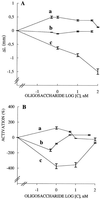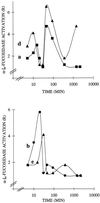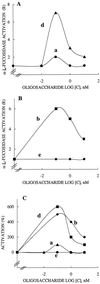Xyloglucan octasaccharide XXLGol derived from the seeds of hymenaea courbaril acts as a signaling molecule
- PMID: 9501133
- PMCID: PMC35070
- DOI: 10.1104/pp.116.3.1013
Xyloglucan octasaccharide XXLGol derived from the seeds of hymenaea courbaril acts as a signaling molecule
Abstract
Treatment of the xyloglucan isolated from the seeds of Hymenaea courbaril with Humicola insolens endo-1,4-beta-d-glucanase I produced xyloglucan oligosaccharides, which were then isolated and characterized. The two most abundant compounds were the heptasaccharide (XXXG) and the octasaccharide (XXLG), which were examined by reference to the biological activity of other structurally related xyloglucan compounds. The reduced oligomer (XXLGol) was shown to promote growth of wheat (Triticum aestivum) coleoptiles independently of the presence of 2, 4-dichlorophenoxyacetic acid (2,4-D). In the presence of 2,4-D, XXLGol at nanomolar concentrations increased the auxin-induced response. It was found that XXLGol is a signaling molecule, since it has the ability to induce, at nanomolar concentrations, a rapid increase in an alpha-l-fucosidase response in suspended cells or protoplasts of Rubus fruticosus L. and to modulate 2,4-D or gibberellic acid-induced alpha-l-fucosidase.
Figures





References
-
- Aldington S, Fry SC. Oligosaccharins. Adv Bot Res. 1993;19:1–107.
-
- Armand S, Drouillard S, Schülein M, Henrissat B, Driguez H. A bifunctionalized fluorogenic tetrasaccharide as a substrate to study cellulases. J Biol. 1997;272:2709–2713. - PubMed
-
- Augur C, Stiefeld V, Darvill AG, Albersheim P, Puigdomenech P. Molecular cloning and pattern of expression of an α-l-fucosidase gene from pea seedlings. J Biol Chem. 1995;270:24839–24843. - PubMed
-
- Braccini I, Hervé du Penhoat C, Michon V, Goldberg R, Clochard M, Jarvis MC, Huang Z-H, Gage DA. Structural analysis of cyclamen seed xyloglucan oligosaccharides using cellulase digestion and spectroscopic methods. Carbohydr Res. 1995;276:167–181. - PubMed
LinkOut - more resources
Full Text Sources

